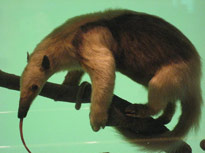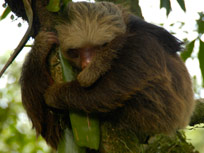Pilosa -- Anteaters and Sloths, a'calm and slumbering



Origins
The order Pilosa, the word pilosus means hairy in latin, is a group of placental mammals, found today only in the Americas. It includes the anteaters and sloths, including the recently(that transalates to 20,000 years ago in plain English) extinct ground sloths. The origins of the Pilosa is still unclear but they can be traced back in South America as far as the early Tertiary.
What are they like?
There are two very different type of creatures, in terms of looks and behavior, in this order. The Anteaters are specialised to eat ants and termites. Their jaws have become longer snouts, their teeth have receded and their tongues have become longer. These animals have very strong forelegs which are specialized for digging up termites nests or ant hills and also perhaps as a means of defense against its most common predators, the jaguars.
The sloths on the other hand, have specialized in eating leaves. Their canine teeth have receded and they now have ever-growing peg-like molars. They are rather slow and ponderous beasts but not because they are lazy. They have a very low nutrition diet plus they need to be stealthy in the environment in which they live. They are known to use they claws when threatened but otherwise their defenses are easily breached. They are tree-dwelling and hang upside down most of the time although when the need arises they can swim very well and will move about the ground too. Interestingly, their fur curves from the stomach to the back, unlike most mammals, allowing rain to run off.
Geographic Distribution
View Larger Map
Pilosa are found in Central and South America and nowhere else in the world. Some species are threatened but overall, this order is holding its own in the wild.
Reproduction
For Anteaters, a pregnancy can last as long as 190 days and the young are carried on the mother's back for a long while. Sloth pregnancies can also last close to a year with the young weaned in a month's time. The babies do stay with their mother for another four months. Sloths generally reach maturity within about 3 years time.
Feeding Habits
Sloths feed entirely on leaves and anteaters relish termites and ants by the thousands. Giant Anteaters can wolf down 30,000 ants a day. Sloths, meanwhile eat their way leisurely through their domain. They live up in the trees(arboreal) and have plenty to munch on to their heart's content.
Families within pilosa
Cyclopedidae (Silky Anteater)
Myrmecophagidae (Giant Anteater)
Bradypodidae (Three-Toed Sloths)
Megalonychidae (Two-Toed Sloths)
Videos